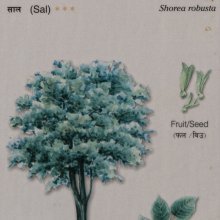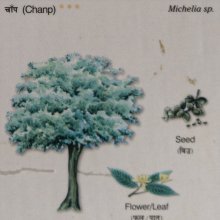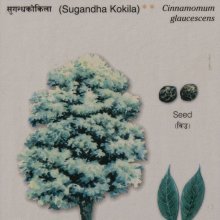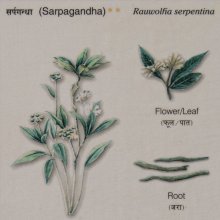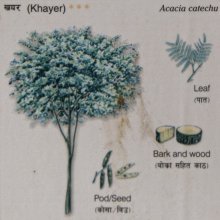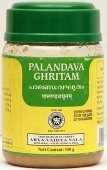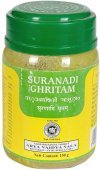Pata, Paṭa, Pāta, Pātā: 40 definitions
Introduction:
Pata means something in Buddhism, Pali, Hinduism, Sanskrit, Jainism, Prakrit, the history of ancient India, Marathi, Hindi, biology, Tamil. If you want to know the exact meaning, history, etymology or English translation of this term then check out the descriptions on this page. Add your comment or reference to a book if you want to contribute to this summary article.
Alternative spellings of this word include Paat.
Images (photo gallery)
(+183 more images available)
In Hinduism
Purana and Itihasa (epic history)
Source: Cologne Digital Sanskrit Dictionaries: The Purana Index1a) Paṭa (पट).—The painting canvas frame on which portraits were drawn. Citralekhā drew a good number of portraits for Uṣa's choice of a husband.*
- * Viṣṇu-purāṇa V. 32. 22-5.
1b) A musical instrument.*
- * Vāyu-purāṇa 40. 24; Matsya-purāṇa 261. 55.
Pāṭa (पाट) is a name mentioned in the Mahābhārata (cf. I.52.16) and represents one of the many proper names used for people and places. Note: The Mahābhārata (mentioning Pāṭa) is a Sanskrit epic poem consisting of 100,000 ślokas (metrical verses) and is over 2000 years old.

The Purana (पुराण, purāṇas) refers to Sanskrit literature preserving ancient India’s vast cultural history, including historical legends, religious ceremonies, various arts and sciences. The eighteen mahapuranas total over 400,000 shlokas (metrical couplets) and date to at least several centuries BCE.
Jyotisha (astronomy and astrology)
Source: Wisdom Library: Brihat Samhita by VarahamihiraPaṭa (पट) or Paṭṭa refers to a “gold ornament for the forehead”, according to the Bṛhatsaṃhitā (chapter 2), an encyclopedic Sanskrit work written by Varāhamihira mainly focusing on the science of ancient Indian astronomy astronomy (Jyotiṣa).—Accordingly, “A true Astrologer is also one who has thoroughly mastered the Science of Saṃhitā. [...] It also treats of the prediction of events from the flight of the kañjana and from the appearance of various abnormal phenomena, of expiatory ceremonies; of miscellaneous planetary phenomena; of ghṛta-kambala; of the royal sword; of paṭa; of the features of a house cock, a cow, a sheep, a horse, an elephant, a man and a woman. It also treats of the treatment of women; of moles in the body; of injuries to shoes and clothes; of hairy fans; of walking sticks: of beds and seats; of lamplight; of tooth brush and the like”.
Source: Wikibooks (hi): Sanskrit Technical TermsPāta (पात).—1. An astrologically significant event when the longitudes of the Sun and Moon add up to 180° or 360° (equivalently 6 or 12 zodiacal signs). 2. The ascending node of a planet's orbit on the ecliptic. 3. The circumference cum in-centre cum ortho-centre of an equilateral triangle. Note: Pāta is a Sanskrit technical term used in ancient Indian sciences such as Astronomy, Mathematics and Geometry.
Source: Indian National Science Academy: Annual Report 2015-16 (astronomy)Pāta (पात) refers to the “fault”, as explained in the pre-7th century Somasiddhānta (chapter 9): an important astronomical treatise containing ten chapters (three hundred thirty five verses) described by Candra to sage Saunaka.

Jyotisha (ज्योतिष, jyotiṣa or jyotish) refers to ‘astronomy’ or “Vedic astrology” and represents the fifth of the six Vedangas (additional sciences to be studied along with the Vedas). Jyotisha concerns itself with the study and prediction of the movements of celestial bodies, in order to calculate the auspicious time for rituals and ceremonies.
Ayurveda (science of life)
Kalpa (Formulas, Drug prescriptions and other Medicinal preparations)
Source: Shodhganga: Edition translation and critical study of yogasarasamgrahaPāṭa [in the Malayalam language] is another name for “Pāṭhā” and is dealt with in the 15th-century Yogasārasaṅgraha (Yogasara-saṅgraha) by Vāsudeva: an unpublished Keralite work representing an Ayurvedic compendium of medicinal recipes. The Yogasārasaṃgraha [mentioning pāṭa] deals with entire recipes in the route of administration, and thus deals with the knowledge of pharmacy (bhaiṣajya-kalpanā) which is a branch of pharmacology (dravyaguṇa).
Unclassified Ayurveda definitions
Source: gurumukhi.ru: Ayurveda glossary of termsPāta (पात):—[pātaḥ] 1. Falling 2. Drooping

Āyurveda (आयुर्वेद, ayurveda) is a branch of Indian science dealing with medicine, herbalism, taxology, anatomy, surgery, alchemy and related topics. Traditional practice of Āyurveda in ancient India dates back to at least the first millenium BC. Literature is commonly written in Sanskrit using various poetic metres.
Shaktism (Shakta philosophy)
Source: Google Books: ManthanabhairavatantramPaṭa (पट) refers to “cloth”, according to Abhinava’s Tantrāloka verse 6.2-4.—Accordingly, “The places are said to be of three kinds: in the vital breath, in the body and outside (the body). The breath is five-fold in the body. (Thus, place) is of two kinds, according to whether it is outside (the body) or within (it). The external (places) are the maṇḍala, the sacrificial ground (sthaṇḍila), the (sacrificial) vessel (pātra), the rosary (akṣasūtra), the book (pustaka), the Liṅga, the skull (tūra), the cloth (paṭa), the image (made of papier-mâché) (pusta), the idol (pratimā), and the divine effigy (mūrti). Thus the outer (place) is of eleven kinds (each which are of) countless varieties. ”.
Source: ORA: Amanaska (king of all yogas): (shaktism)Paṭa (पट) refers to “cloth” or “dress”, according to the 17th century Kaulagajamardana (“crushing the Kaula elephant”) authored by Kāśīnātha or Kṛṣṇānandācala.—Accordingly, [as Īśvara said to Pārvatī]: “[...] O great Goddess, hear about the Jain. He always carries a pitcher. He is simply a soul and never an enjoyer, doer and destroyer. He is called a Jain, and Buddhists and [the like] are considered [to be similar]. Some pluck out their hair and dress in white (śveta-paṭa), my dear, and [some] wear red garments and [others wear] indigo and so on. Some are called, 'great guru', and others pursue nonviolence. These are the different varieties in brief; they are [all] called Pāṣaṇḍas [because] they have been excluded from the vedic path. [...]”

Shakta (शाक्त, śākta) or Shaktism (śāktism) represents a tradition of Hinduism where the Goddess (Devi) is revered and worshipped. Shakta literature includes a range of scriptures, including various Agamas and Tantras, although its roots may be traced back to the Vedas.
Shaivism (Shaiva philosophy)
Source: Brill: Śaivism and the Tantric TraditionsPāta (पात) refers to the “fall (of the body)”, according to the Īśvarapratyabhijñāvimarśinī III.2.12.—Accordingly, “But at the fall of the body (deha-pāta), there is only one essence: the Supreme Lord. Thus, who could enter (/immerse), where and how?”.
Source: SOAS University of London: Protective Rites in the Netra TantraPaṭa (पट) refers to a “cloth”, according to the Netratantra of Kṣemarāja: a Śaiva text from the 9th century in which Śiva (Bhairava) teaches Pārvatī topics such as metaphysics, cosmology, and soteriology.—Accordingly, [verse 10.1-7ab, while describing the appearance and worship of Bhairava]—“[...] He [is] mounted on a lion, wears a snake garland, bears a mālā, and begging bowl. [He has] a torn mouth from [which he emits] a great roar. [His body is] covered by a cloth of elephant skin (gajatvac-prāvṛta-paṭa), a flower crown, [and] the moon. [Bhairava] holds a skull-topped staff and skull bowl. [...] Having worshipped Bhairava, [the Mantrin] remembers being joined in union [with] him, [in the same way as] dissolution in fire”.

Shaiva (शैव, śaiva) or Shaivism (śaivism) represents a tradition of Hinduism worshiping Shiva as the supreme being. Closely related to Shaktism, Shaiva literature includes a range of scriptures, including Tantras, while the root of this tradition may be traced back to the ancient Vedas.
Kavya (poetry)
Source: Brill: Śaivism and the Tantric Traditions (kavya)Paṭa (पट) refers to “cloths”, according to Bāṇa’s Kādambarī (p. 225-226).—Accordingly, while describing the shire of the Goddess Caṇḍikā, “[Then follows the image of the Goddess Caṇḍikā, which matches the conception of Kālarātri in the passage from the Mahābhārata:] Her feet were never bereft of cloths [dyed with] red lac (alaktaka-paṭa) thrown upon the mound of her seat [on the altar] as if they were the lives of all creatures arrived there for shelter; she resembled an inhabitant of the Underworld because of the intense darkness obstructed [only] by the flashes from axes, spears, etc., weapons deadly for beings, that seemed to hold nets of hair stuck from decapitations because of the reflections of black yak-tail whisks cast [upon their surfaces]; [...]”.

Kavya (काव्य, kavya) refers to Sanskrit poetry, a popular ancient Indian tradition of literature. There have been many Sanskrit poets over the ages, hailing from ancient India and beyond. This topic includes mahakavya, or ‘epic poetry’ and natya, or ‘dramatic poetry’.
Sports, Arts and Entertainment (wordly enjoyments)
Source: archive.org: Syainika Sastra of Rudradeva with English Translation (art)Pāta (पात) refers to the “fall” (of a hawk), according to the Śyainika-śāstra: a Sanskrit treatise dealing with the divisions and benefits of Hunting and Hawking, written by Rājā Rudradeva (or Candradeva) in possibly the 13th century.—Accordingly, [while discussing the black-eyed division of hawks]: “[...] Like servants they become serviceable if their expectations are raised, and if they are rewarded according to their deserts. This class is quick to hear a distant call, to fall on distant prey (dūra-pāta) and capture big quarry. The second class will now be treated of. [...]”.

This section covers the skills and profiencies of the Kalas (“performing arts”) and Shastras (“sciences”) involving ancient Indian traditions of sports, games, arts, entertainment, love-making and other means of wordly enjoyments. Traditionally these topics were dealt with in Sanskrit treatises explaing the philosophy and the justification of enjoying the pleasures of the senses.
In Buddhism
Theravada (major branch of Buddhism)
Source: Dhamma Dana: Pali English GlossaryN (Bowl).
Theravāda is a major branch of Buddhism having the the Pali canon (tipitaka) as their canonical literature, which includes the vinaya-pitaka (monastic rules), the sutta-pitaka (Buddhist sermons) and the abhidhamma-pitaka (philosophy and psychology).
Mahayana (major branch of Buddhism)
Source: Wisdom Library: Maha Prajnaparamita SastraPaṭa (पट) refers to “cloth”, according to Mahāprajñāpāramitāśāstra (chapter 2).—Accordingly, “[Question: If one-ness and substance are the same, what is the fault?]—If a vase (ghata) is synonymous with one-ness, in the way that Indra is synonymous with Śakra, then wherever there is one-ness, there must be a vase, as everywhere where there is Indra, there must be Śakra. Henceforth all substances, cloth (paṭa), etc., will be vase and one-ness. Since the vase is one-ness, wherever there is one-ness, there must be vase, and not only vase, but also cloth, etc., because all of them being ‘single’ substance, they are not different (viśeṣa)”.
Source: academia.edu: A Study and Translation of the GaganagañjaparipṛcchāPāta (पात) refers to a “bowl” (for alms), according to the Gaganagañjaparipṛcchā: the eighth chapter of the Mahāsaṃnipāta (a collection of Mahāyāna Buddhist Sūtras).—Accordingly, as the Lord said to Brahmā Prabhāvyūha: “[...] (9) Further, ‘the root of good’ is being easily satisfied with food, ‘merit’ is effortlessly obtaining dhrama-robes (cīvara) and alms-bowls (piṇḍa-pāta), and ‘knowledge’ is to use them without desire or greed. (10) Further, ‘the root of good’ is to practice the presences of recollection, ‘merit’ is fulfilling the correct eliminations, ‘knowledge’ is attaining the bases of magical power. [...]”.

Mahayana (महायान, mahāyāna) is a major branch of Buddhism focusing on the path of a Bodhisattva (spiritual aspirants/ enlightened beings). Extant literature is vast and primarely composed in the Sanskrit language. There are many sūtras of which some of the earliest are the various Prajñāpāramitā sūtras.
In Jainism
Jain philosophy
Source: archive.org: Anekanta Jaya Pataka of Haribhadra SuriPaṭa (पट) refers to a “piece of cloth”, as occurring in the Anekāntajayapatākā-prakaraṇa, a Śvetāmbara Jain philosophical work written by Haribhadra Sūri.—[Cf. Vol. I, P. 169, l. 6]—‘Paṭa’ means a piece of cloth, a garment and ‘kaṭa’ ( a homonym), a mat or a kind of grass.
-
General definition (in Jainism)
Source: The University of Sydney: A study of the Twelve ReflectionsPāta (पात) refers to “going down” (i.e., ‘to go reeling down [to unhappy births]’), according to the Yaśastilaka Campū verse 2.215-216.—Accordingly, “The Self is by nature deathless and without any beginning, endowed with bliss and infinite power, and luminous and pure. The powerful flames of sinful Karma heat it, like mercury, after lodging it in the body. Under the intoxicating power of Karma, even a man of superior merit goes reeling down (pāta) to unhappy births. Se [sic] let the wise, who know the cardinal difference between the body and the Self, strive for the bliss that is free from rebirth”.

Jainism is an Indian religion of Dharma whose doctrine revolves around harmlessness (ahimsa) towards every living being. The two major branches (Digambara and Svetambara) of Jainism stimulate self-control (or, shramana, ‘self-reliance’) and spiritual development through a path of peace for the soul to progess to the ultimate goal.
India history and geography
Source: archive.org: Glossary of Sinhalese Folk Terms appearing in the Service Tenure RegisterPata:—A measure corresponding to a hunduwa. One-fourth of a seer. The same as Awaliya.
Source: Cologne Digital Sanskrit Dictionaries: Indian Epigraphical GlossaryPaṭa or Paṭā or Pāṭa.—(EI 28; Chamba), charter, deed; same as Sanskrit paṭṭa or paṭṭaka. Note: paṭa is defined in the “Indian epigraphical glossary” as it can be found on ancient inscriptions commonly written in Sanskrit, Prakrit or Dravidian languages.
--- OR ---
Pāṭa.—cf. daṇḍapāṭa. Note: pāṭa is defined in the “Indian epigraphical glossary” as it can be found on ancient inscriptions commonly written in Sanskrit, Prakrit or Dravidian languages.

The history of India traces the identification of countries, villages, towns and other regions of India, as well as mythology, zoology, royal dynasties, rulers, tribes, local festivities and traditions and regional languages. Ancient India enjoyed religious freedom and encourages the path of Dharma, a concept common to Buddhism, Hinduism, and Jainism.
Biology (plants and animals)
Source: Wisdom Library: Local Names of Plants and DrugsPata [பாடா] in the Tamil language is the name of a plant identified with Cyclea peltata Hook. fil. & Thoms. from the Menispermaceae (Moonseed) family having the following synonyms: Cyclea burmanii, Cyclea versicolor, Cyclea discolor. For the possible medicinal usage of pata, you can check this page for potential sources and references, although be aware that any some or none of the side-effects may not be mentioned here, wether they be harmful or beneficial to health.
Source: Google Books: CRC World Dictionary (Regional names)1) Pata in Central America is the name of a plant defined with Psidium guajava in various botanical sources. This page contains potential references in Ayurveda, modern medicine, and other folk traditions or local practices It has the synonym Syzygium ellipticum K. Schum. & Lauterb. (among others).
2) Pata in India is also identified with Aristolochia bracteata.
3) Pata is also identified with Buchanania lanzan It has the synonym Buchanania latifolia Roxb..
4) Pata is also identified with Cissampelos pareira It has the synonym Cocculus villosus Wall., nom. illeg. (etc.).
5) Pata is also identified with Corchorus capsularis.
6) Pata is also identified with Corchorus olitorius.
7) Pata in Nepal is also identified with Rhododendron arboreum.
Example references for further research on medicinal uses or toxicity (see latin names for full list):
· Flora Analítica e Fitogeográfica do Estado de São Paulo (1970)
· Lilloa (1966)
· Journal of Fujian Agricultural College (1986)
· Flora Brasiliensis (1825)
· Numer. List (3587)
· Quarterly Journal of the Mythic Society (1963)
If you are looking for specific details regarding Pata, for example diet and recipes, chemical composition, extract dosage, side effects, health benefits, pregnancy safety, have a look at these references.

This sections includes definitions from the five kingdoms of living things: Animals, Plants, Fungi, Protists and Monera. It will include both the official binomial nomenclature (scientific names usually in Latin) as well as regional spellings and variants.
Languages of India and abroad
Pali-English dictionary
Source: BuddhaSasana: Concise Pali-English Dictionarypaṭa : (m.; nt.) a cloth; garment. || pāta (m.) a fall; a throw.
Source: Sutta: The Pali Text Society's Pali-English DictionaryPaṭa, (cp. Epic Sk. paṭa, etym. unknown, prob. dialectical) cloth; cloak, garment S. II, 219 (°pilotika); Th. 1, 1092 (bhinna-paṭan-dhara “wearing the patchwork cloak” trsl.); J. IV, 494; KhA 45, 58 (°tantu); DA. I, 198; DhA. II, 45 (puppha°); III, 295 °kañcuka, v. l. kaṭak°); Vism. 16 (bhinna-paṭa-dhara in definition of bhikkhu); VbhA. 327 (id.); DhsA. 81 (paṭa-paṭa sadda); VvA. 73, 201; PvA. 185. Cp. paṭikā & paṭalikā; also kappaṭa. (Page 391)
— or —
Pāta, (-°) (fr. pat) 1. fall DA. I, 95 (ukkā°); PvA. 45 (asani°). The reading “anatthato pātato rakkhito” at PvA. 61 is faulty we should prefer to read apagato (apāyato?) rakkhito.—2. throwing, a throw Sn. 987 (muddha°); PvA. 57 (akkhi°). See also piṇḍa. (Page 451)

Pali is the language of the Tipiṭaka, which is the sacred canon of Theravāda Buddhism and contains much of the Buddha’s speech. Closeley related to Sanskrit, both languages are used interchangeably between religions.
Marathi-English dictionary
Source: DDSA: The Molesworth Marathi and English Dictionarypaṭa (पट).—m f (paṭṭa S) A chequered board or cloth (to play at chess, songṭya &c.) 2 A roll, list, catalogue (as of names): a roll, record, chronicle: a writing registering particulars or exhibiting the rule and practice; a table or a schedule: also, as saṅkrāntipaṭa, grahaṇapaṭa, lagnapaṭa, muhūrttapaṭa, a paper detailing (with astrological reference) the points and items connected with the sun's passage through the signs; with eclipses, auspicious periods and conjunctions &c.: also a string of pictures pasted one to another. 3 S Cloth. 4 n A fold (of a door or window-shutter). 5 A confederate or banded body. 6 A very large slip of land. 7 f In comp. with a numeral prefix. The state or being of a quantity taken as often as the prefixed numeral denotes. Ex. dhānvācī dāhāpaṭa jhālī; paikyācī vīsapaṭa jhālī The grain has increased to a ten-fold quantity; the money is become a twenty-fold heap.
--- OR ---
paṭa (पट).—ad (opp. to cīta With face or mouth upwards. ) With face or mouth downwards--a coin or a cowrie falling.
--- OR ---
paṭa (पट).—ind An adjunct assumed by the numerals and adverbs of quantity, corresponding to Fold, as dupaṭa, pāñcapaṭa, kitipaṭa, jitakāpaṭa. It signifies the same number or quantity repeated; and to the extent denoted by the numeral prefix.
--- OR ---
pata (पत).—f Credit, reputation for probity; esp. among mercantile people. patīvara pāṇī paḍaṇēṃ g. of s. To have one's mercantile credit blasted, shocked, injured. patīsa caḍhaṇēṃ To grow in credit.
--- OR ---
pāṭa (पाट).—m (pīṭha S) A stool. 2 An elevated water-course (to convey water through a plantation or field). Applied, by metonymy, to the water conveyed. 3 A second and an inferior sort of marriage, esp. among the widows of the lower classes. v lāva, kara with śīṃ of o. Ordinarily pāṭa is Taking a second husband (named pāṭācā navarā); yet, sometimes, Marrying a widow. 4 (paṭṭa S) A breadth of cloth. 5 A line formed by the razor along the hair of the head. v kāḍha. 6 The breadth of a river. 7 n The springing of the bull or buffalo in covering the female. 8 m A strip or line of corn or vegetables along the field or plantation. 9 That member of a spinning wheel (the wooden slip having three cross rows of pegs) on which the thread is wound. 10 The piece placed across the top of a post and under the beam. 11 f (Or pāṭha) A female kid.
--- OR ---
pāṭā (पाटा).—m (paṭṭa S) The slab upon which are ground or bruised the ingredients of condiment, medicaments &c. 2 fig. Table-land; any level or plain. 3 Lance leaved Sida, Sida lanceolata. 4 A mass of iron or stone used in small boats for an anchor. 5 A common term for the pieces composing the periphery of a wheel.
--- OR ---
pāta (पात).—n The blade of a tool or weapon. 2 An eyelid. 3 C A very young cocoanut-tree. 4 f The team of oxen at a treading floor. 5 m The name of a seawater-fish. 6 The eye or hole of an ax, adz &c.
--- OR ---
pāta (पात).—m (S) Falling or descending. 2 The seventeenth of the astronomical yōga. 3 (Or kṣēpa- pāta) The ascending node of a planet's orbit. 4 Equality of the declinations of the sun and moon.
--- OR ---
pāta (पात).—f m W An odoriferous plant. Commonly pāca q. v.
--- OR ---
pāta (पात).—m (patra S) A pinnate or a long-shaped leaf (as of the Cocoanut, sugarcane &c.) 2 In the sense of Leaf generally it occurs only in the saying hātāvara miḷavāvēṃ āṇi pātāvara khāvēṃ (To earn and to eat,--to live from hand to mouth).
--- OR ---
pāta (पात) [or पांत, pānta].—f (paṅkti S) The line (in a rice-field) along which the man proceeds fixing or uprooting plants of rice; the line (in a corn-field) taken up in reaping; the line (on a roof) along which the tiler or thatcher proceeds laying or taking up the tiles or thatch; a line (team) of oxen in treading out corn; a line or row more freely, and, in some districts, generally. Note. The speciality of sense is rather that of pānta, and it pertains to the Konkan̤: in the Desh pāta is Line or row generally. v dhara, lāga. Ex. majūrakaṛyāñcē barōbarīṃ || āpaṇa pāta dharī dusarī || saprēma prēmāciyē gajarīṃ|| tukayā karī saṃvagaṇī||.
Source: DDSA: The Aryabhusan school dictionary, Marathi-Englishpaṭa (पट).—m f A chequered board or cloth (to play at chess, songtya &c.) A roll- list. A roll, record. Cloth. n A fold (of a door or window-shutter). f In comp. with a numeral prefix. The state or being of a quality taken as often as the prefixed numeral deno- tes. Ex. dhānyācī dahāpaṭa jhālī. The grain has increased to a ten-fold quantity.
--- OR ---
paṭa (पट).—ad With face or mouth downwards-a coin or a cowrie falling.
--- OR ---
pata (पत).—f Credit. patīvara pāṇī pāḍaṇēṃ To have one's mercantile credit blasted, injured. patīsa caḍhaṇēṃ To grow in credit.
--- OR ---
pāṭa (पाट).—m A stool. An elevated water- course to convey water to a planta- tion or field. Widow marriage. A breadth of cloth. A sweep of the razor. pāñca pāṭa kāḍhaṇēṃ To shave off the hair of the head in five lines (as of a thief &c. by way of punishment.).
--- OR ---
pāta (पात).—n The blade of a tool or weapon. An eyelid. m Falling or descending.
--- OR ---
pāṭa (पाट).—or-
Marathi is an Indo-European language having over 70 million native speakers people in (predominantly) Maharashtra India. Marathi, like many other Indo-Aryan languages, evolved from early forms of Prakrit, which itself is a subset of Sanskrit, one of the most ancient languages of the world.
Sanskrit dictionary
Source: DDSA: The practical Sanskrit-English dictionaryPaṭa (पट).—[paṭ veṣṭane karaṇe ghañarthe kaḥ]
1) A garment, raiment, cloth, a piece of cloth; अयं पटः सूत्रदरिद्रतां गतो ह्ययं पटश्छिद्रशतैरलंकृतः (ayaṃ paṭaḥ sūtradaridratāṃ gato hyayaṃ paṭaśchidraśatairalaṃkṛtaḥ) &c. Mṛcchakaṭika 2.9; मेघाः स्रवन्ति बलदेवपटप्रकाशाः (meghāḥ sravanti baladevapaṭaprakāśāḥ) 5.45.
2) Fine cloth.
3) A veil, screen.
4) A tablet, plate or piece of cloth for writing or painting upon.
-ṭaḥ Anything well made or polished.
-ṭam A thatch, roof.
Derivable forms: paṭaḥ (पटः), paṭam (पटम्).
--- OR ---
Pata (पत).—a.
1) Cherished, well-fed, protected (puṣṭa).
2) Flying, falling.
-taḥ 1 Flying, flight.
2) Going, falling, alighting.
--- OR ---
Pāṭa (पाट).—1 Extension, breadth.
2) (In geometry) The intersection of a prolonged side and perpendicular, or the figure formed by such intersection.
-ṭā 1 A series, order.
2) A species of plant.
Derivable forms: pāṭaḥ (पाटः).
--- OR ---
Pāta (पात).—p. p. Protected, guarded &c.; see पा (pā).
--- OR ---
Pāta (पात).—[pat-ghañ]
1) Flying, flight.
2) Alighting, descending, descent.
3) Falling down, fall, downfall (fig. also); द्रुम°, गृह° (druma°, gṛha°); &c. चरणपातः (caraṇapātaḥ) 'falling down at the feet'; तस्याभवत् क्षणशुचः परितोषलाभः कक्षाग्निलङ्घिततरोरिव वृष्टि- पातः (tasyābhavat kṣaṇaśucaḥ paritoṣalābhaḥ kakṣāgnilaṅghitataroriva vṛṣṭi- pātaḥ) R.11.92; पातोत्पातौ (pātotpātau) 'rise and fall.'
4) Destruction, dissolution, ruin; आसीनमासन्नशरीरपातस्त्रियम्बकं संयमिनं ददर्श (āsīnamāsannaśarīrapātastriyambakaṃ saṃyaminaṃ dadarśa) Kumārasambhava 3.44.
5) A blow, stroke; as in खड्गपातः (khaḍgapātaḥ).
6) Shedding, discharging, emitting; असृक्पातैः (asṛkpātaiḥ) Manusmṛti 8.44.
7) A cast, throw, shot; कुरुष्व तावत् करभोरु पश्चान्मार्गे मृगप्रेक्षिणि दृष्टिपातम् (kuruṣva tāvat karabhoru paścānmārge mṛgaprekṣiṇi dṛṣṭipātam) R.13.18.
8) An attack, inroad.
9) Happening, coming to pass, occurrence.
1) A failing, defect.
11) An epithet of Rāhu; दक्षिणोत्तरतोऽप्येवं पातु राहुः स्वरंहसा । विक्षिपत्येष विक्षेपं चन्द्रादीनामपक्रमात् (dakṣiṇottarato'pyevaṃ pātu rāhuḥ svaraṃhasā | vikṣipatyeṣa vikṣepaṃ candrādīnāmapakramāt) || Sūrya S.
12) (In astr.) An inauspicious or malignant position or aspect.
13) The node in a planet's orbit.
14) Application (of ointment, of a knife &c.).
Derivable forms: pātaḥ (पातः).
Source: Cologne Digital Sanskrit Dictionaries: Edgerton Buddhist Hybrid Sanskrit DictionaryPaṭa (पट).—m. (rarely nt.), (1) cloth, as in Sanskrit, seemingly in very general sense: in Mahāvyutpatti 5864, 9168 Tibetan snam bu, which is said to mean woolen cloth (contrast paṭaka Mahāvyutpatti 9169); in Saddharmapuṇḍarīka 75.7 (prose) both Burnouf (who reads paṭṭa, see his note p. 369—370) and Kern translate silk; the word is [compound] with prec. duṣya- or dūṣya-, q.v.; B. and K. regard the [compound] as a dvandva, but it is surely a karmadh., meaning some kind of fine cloth (see duṣya); in Kāraṇḍavvūha 81.6 f. (likewise in Mahāvastu ii.157.7) it also means cloth in general, as used to garb persons initiated in various religious orders, see s.v. indra-paṭa; (2) in Mahāvastu iii.31.11 apparently piece, fragment (of a stone; compare Sanskrit paṭati, splits), if the text is right: (upalānāṃ) paṭaṃ (so mss., Senart paṭāṃ) chittvā, splitting off a piece of the stones; (3) in Lalitavistara 315.15 (verse) assumed to be a kind of bird, but reading uncertain; Lefm. [Page316-a+ 71] vīkṣasva bodhimaṇḍe paṭukroñcāhaṃsakokilamayūrāḥ, with v.l. paṭa for paṭu; Calcutta (see LV.) paṭa-; Tibetan pa ta kun ta (presumably understanding it as name of a single bird) for paṭa(or paṭu-)kroñca (the rest of the [compound] is correctly ren- dered in Tibetan); neither paṭa nor paṭu seems to be known as a bird-name; if paṭu is right, could it not be taken as adv. with vīkṣasva ? look keenly, sharply, at the…; [(4) on Lalitavistara 127.17 for paṭopachedana read vaṭṭopa°, supported by best ms. and Pali; see s.v. vaṭṭa.]
--- OR ---
Pāta (पात).—m., attainment, getting, what comes or is got: bhikṣūṇāṃ cīvara-pāto (Tibetan rñed pa = lābha) deyaḥ Mūla-Sarvāstivāda-Vinaya ii.97.6; in this sense also in piṇḍa-pāta, q.v.
Source: Cologne Digital Sanskrit Dictionaries: Shabda-Sagara Sanskrit-English DictionaryPaṭa (पट).—mn.
(-ṭaḥ-ṭaṃ) 1. Fine cloth. 2. Coloured cloth. 3. A leaf or sheet of cloth, &c. on which any figures may be painted. 4. A veil or screen. 5. A tablet for writing or painting. m.
(-ṭaḥ) 1. A kind of tree: see piyāla. 2. Any thing well made or polished. f. (-ṭī) 1. A particular sort of cloth, coarse thick cloth, canvas. 2. A screen of cloth surrounding a tent, an outer tent. 3. A coloured or chintz garment. n.
(-ṭaṃ) A thatch, a roof. E. paṭa to surround, aff. ac fem. aff. ṅīpḥ see paṭi.
--- OR ---
Pata (पत).—mfn.
(-taḥ-tā-taṃ) Cherished, protected. m.
(-taḥ) 1. Going, 2. Falling, alighting. 3. Flying, flight. E. pat to go, ac aff. or a various reading of pāta.
--- OR ---
Pāṭa (पाट).—m.
(-ṭaḥ) Breadth, expanse, extension. f.
(-ṭā) Regular or successive order, series, succession. E. paṭ to spread, aff. ghañ .
--- OR ---
Pāta (पात).—mfn.
(-taḥ-tā-taṃ) Preserved, protected. E. pā to preserve, aff. kta. m.
(-taḥ) 1. Falling, alighting, descending. 2. A name of Rahu. 3. The node of a planet’s orbit. 4. Flying, flight. 5. A stroke, as in khaṅgapāta . 6. Shedding, emitting, discharging. 7. An attack, an inroad. 8. Happening. 9. Failing, defect. 10. Destruction, dissolution. E. pat to fall, aff. ghañ.
Source: Cologne Digital Sanskrit Dictionaries: Benfey Sanskrit-English DictionaryPaṭa (पट).— (probably for patra), m. and f. ṭī, and n. 1. Woven cloth, Mahābhārata 1, 806. 2. Cloth, [Rāmāyaṇa] 5, 49, 5. 3. A piece of cloth, Mahābhārata 1, 4376. 4. Garment, 5421. 5. (cf. paṭṭa), A table, a plate (for painting and writing), [Yājñavalkya, (ed. Stenzler.)] 1, 297. 6. f. ṭī, The curtain of a stage.
--- OR ---
Pāta (पात).—i. e. pat + a, m. 1. Flying, Mahābhārata 8, 1898. 2. Manner of flying, 3, 10646. 3. Throwing one’s self, [Bhartṛhari, (ed. Bohlen.)] 2, 77. 4. Falling. 5. A cast. 6. A stroke. khaḍga-, A stroke with the sword, [Kathāsaritsāgara, (ed. Brockhaus.)] 27, 50. 7. Case, [Lassen, Anthologia Sanskritica.] 43, 3.
Source: Cologne Digital Sanskrit Dictionaries: Cappeller Sanskrit-English DictionaryPaṭa (पट).—[masculine] (woven) cloth, blanket, garment; picture, image of (—°); [feminine] ī piece of cloth, screen, curtain ([drama]).
--- OR ---
Pāṭa (पाट).—[masculine] intersection; [feminine] pāṭā [Name] of a cert. plant.
--- OR ---
Pāta (पात).—[masculine] flying, flight; fall, downfall; attack, inroad; case, possibility; happening, event.
Source: Cologne Digital Sanskrit Dictionaries: Monier-Williams Sanskrit-English Dictionary1) Paṭa (पट):—[from paṭ] m. (n., [cf. Lexicographers, esp. such as amarasiṃha, halāyudha, hemacandra, etc.]; ifc. f(ā). ) woven cloth, cloth, a blanket, garment, veil, screen, [Mahābhārata; Kāvya literature] etc. (cf. marut-, vāta-)
2) [v.s. ...] a painted piece of cloth, a picture, [Yājñavalkya; Kādambarī]
3) [v.s. ...] monastic habit, [Kāraṇḍa-vyūha]
4) [v.s. ...] a kind of bird, [Lalita-vistara]
5) [v.s. ...] Buchanania Latifolia, [cf. Lexicographers, esp. such as amarasiṃha, halāyudha, hemacandra, etc.]
6) [v.s. ...] = puras-kṛta, [cf. Lexicographers, esp. such as amarasiṃha, halāyudha, hemacandra, etc.]
7) [from paṭ] n. a thatch or roof (= paṭala), [cf. Lexicographers, esp. such as amarasiṃha, halāyudha, hemacandra, etc.]
8) Pata (पत):—[from pat] 1. pata m. flying, falling (cf. [gana] pacādi and jvalādi).
9) 2. pata mfn. well fed (= puṣṭa), [cf. Lexicographers, esp. such as amarasiṃha, halāyudha, hemacandra, etc.]
10) Pāta (पात):—[from pā] 1. pāta mfn. (for 2. See p. 616, col. 3) watched, protected, preserved, [cf. Lexicographers, esp. such as amarasiṃha, halāyudha, hemacandra, etc.]
11) Pāṭa (पाट):—m. (√paṭ) breadth, expanse, extension, [cf. Lexicographers, esp. such as amarasiṃha, halāyudha, hemacandra, etc.]
12) (in [geometry]) the intersection of a prolonged side and perpendicular or the figure formed by such an intersection, [Colebrooke]
13) = vādya-tūrotkara, [Vikramorvaśī iv, 13/14 [Scholiast or Commentator]]
14) Pāṭā (पाटा):—[from pāṭa] f. a species of plant, [Atharva-veda; Kauśika-sūtra] (cf. pāṭhā)
15) [v.s. ...] regular order, series, succession, [Horace H. Wilson]
16) Pāta (पात):—[from pāt] 2. pāta m. (for 1. See under √3. pā) flying, mode of flying, flight, [Mahābhārata]
17) [v.s. ...] throwing one’s self or falling into ([locative case]) or from ([ablative]), fall, downfall (also ifc. after what would be a [genitive case] or [ablative] etc. e.g., gṛha-, fall of a house; parvata-, fall from a mountain; bhū-, fall on the earth), [Manu-smṛti; Mahābhārata; Kāvya literature] etc.
18) [v.s. ...] alighting, descending or causing to descend, casting or throwing upon, cast, fall (of a thunderbolt), throw, shot, [Mahābhārata; Rāmāyaṇa; Pañcatantra]
19) [v.s. ...] a stroke (of a sword etc.), [Kathāsaritsāgara]
20) [v.s. ...] application (of ointment, of a knife etc.), [Kāvyādarśa]
21) [v.s. ...] casting or directing (a look or glance of the eyes), [Raghuvaṃśa]
22) [v.s. ...] decay of the body (deha-pāta), death, [Kathāsaritsāgara; Bādarāyaṇa’s Brahma-sūtra]
23) [v.s. ...] (with garbhasya) fall of the fetus, miscarriage, [Suśruta]
24) [v.s. ...] an attack, incursion, [Varāha-mihira]
25) [v.s. ...] a case, possibility, [Śāṅkhāyana-brāhmaṇa]
26) [v.s. ...] happening, occurrence, appearance, [Prabodha-candrodaya; Kathāsaritsāgara; Daśarūpa]
27) [v.s. ...] a fault, error, mistake, [Sūryasiddhānta]
28) [v.s. ...] the node in a planet’s orbit, [ib.] (cf. [Indian Wisdom, by Sir M. Monier-Williams 179])
29) [v.s. ...] a malignant aspect, [ib.]
30) [v.s. ...] Name of Rāhu, [cf. Lexicographers, esp. such as amarasiṃha, halāyudha, hemacandra, etc.]
31) [v.s. ...] [plural] Name of a school of the Yajur-veda, [ib.]
Source: Cologne Digital Sanskrit Dictionaries: Yates Sanskrit-English Dictionary1) Paṭa (पट):—[(ṭaḥ-ṭaṃ)] 1. m. n. Fine cloth. f. Canvas; chintz. n. Thatch.
2) Pata (पत):—[(taḥ-tā-taṃ) p.] Cherished. m. Falling
3) Pāṭa (पाट):—(ṭaḥ) 1. m. Breadth. f. (ṭā Series.
4) Pāta (पात):—(taḥ) 1. m. A falling; Rāhu; node of any orbit. a. Preserved.
Source: DDSA: Paia-sadda-mahannavo; a comprehensive Prakrit Hindi dictionary (S)Pāta (पात) in the Sanskrit language is related to the Prakrit words: Ṇihoḍa, Paḍa, Pāḍa, Pāya, Phāḍa, Vāya.
[Sanskrit to German]
Sanskrit, also spelled संस्कृतम् (saṃskṛtam), is an ancient language of India commonly seen as the grandmother of the Indo-European language family (even English!). Closely allied with Prakrit and Pali, Sanskrit is more exhaustive in both grammar and terms and has the most extensive collection of literature in the world, greatly surpassing its sister-languages Greek and Latin.
Hindi dictionary
Source: DDSA: A practical Hindi-English dictionary1) Paṭa (पट) [Also spelled pat]:—(nm) a garment, piece of cloth covering; screen; an allomorph of [paṭṭa] meaning favourite, principal (as [paṭarānī]); a door leaf; tail (of a coin); sound of falling or breaking or beating; septa; groomed lock of hair; (a) lying flat, upside down; ineffective, waste (land); effaced, wiped out; ~[kathā] screen play; ~[kāra] a fabric worker; weaver; ~[paṭa] recurrent sound of ~[paṭa; ~maṃḍapa] pavilion; ~[rānī] the queen consort, the principal wife of a king; —[ughaḍanā/khulanā] the door leaves to (be thrown) open; —[paḍanā] to lie face downwards; (a venture) to come to a standstill; to be slackened/closed down; —[baṃda honā] the door leaves to be shut; —[honā] to come to a nought, to be ruined.
2) Paṭā (पटा):—(nm) a scimitar; cudgel; seating plank or board; ~[ṭebāja] a fencer, one who wields a foil or cudgel with skill; ~[ṭebājī] fencing, playing with foils/cudgels.
3) Pata (पत) [Also spelled pat]:——an allomorph of [pattā] used as the first member of compound words; (nf) honour, dignity; ~[jhaḍa/jhara] the fall, autumn; defoliation; —[uṭha jānā] to lose credit, to be trusted no more; —[utāranā] to disgrace; to compromise the honour of; to humiliate; —[rakhanā] to maintain the dignity of, to preserve the honour of.
4) Patā (पता):—(nm) an address; whereabouts; information, knowledge; [pate kī kahanā] to put the axe in the helve, to hit the right nail on the head; [pate kā bāta] a remarkable/revealing utterance.
5) Pāṭa (पाट) [Also spelled paat]:—(nm) jute; span; width, breadth (as of a river, etc.); a grindstone, mill-stone; a tow; plank; a slab of stone on which a washerman washes his clothes.
6) Pāta (पात) [Also spelled paat]:—(nm) fall, falling; a leaf; —[jharanā] shedding of (tree) leaves.
...
Kannada-English dictionary
Source: Alar: Kannada-English corpusPaṭa (ಪಟ):—
1) [noun] a piece of fabric; cloth.
2) [noun] a cloth of superior quality.
3) [noun] a piece of cloth used as a screen, cover; a veil.
4) [noun] a specially prepared piece of canvas for painting on.
5) [noun] a kind of black cloth used to write on.
6) [noun] a sheet of paper, cloth on which a map, sketch, drawing is written.
7) [noun] a picture or portrait painted (on a canvas).
8) [noun] an extent of the canvas or other strong material by which a vessel is propelled forward through water; a sail.
9) [noun] a light frame covered with some thin material as paper or cloth, with a tail to balance, designed to be flown in the wind at the end of a long string; a kite.
10) [noun] the tree Buchanania latifolia ( = B. lanzan) of Anacardiaceae family.
11) [noun] that which is done well.
12) [noun] a banner; a flag.
13) [noun] ಪಟದ ಕುಣಿತ [patada kunita] paṭada kuṇita a kind of folk dance, performed holding a tall bamboos about which silk cloths of different colours are wound; ಪಟದ ಹಬ್ಬ [patada habba] paṭada habba a festival observed in Āṣāḍa, the fourth month in Hindu lunar calender; ಪಟದ ಹುಳು [patada hulu] paṭada huḷu a kind of worm that eats up clothes; ಪಟವಾಡಿಸು [patavadisu] paṭavāḍisu to fly kites; 2. (fig.) to make another act as per one’s wishes.
--- OR ---
Pata (ಪತ):—[noun] a utensil; a vessel.
--- OR ---
Pata (ಪತ):—[noun] (rightly, ಪಥ [patha]) a way made for traveling between places esp. by vehicles; a road.
--- OR ---
Pāṭa (ಪಾಟ):—[noun] a singing.
--- OR ---
Pāṭa (ಪಾಟ):—
1) [noun] the act or practice of a person who reads; perusal, as of books; reading.
2) [noun] a frequent or usual action; the result of practice; habit; usage.
--- OR ---
Pāṭa (ಪಾಟ):—
1) [noun] a narrow band; a strip.
2) [noun] a piece of cloth, paper, metal, wood, etc. having more length than the width, used for decorative purpose.
3) [noun] an ornamental, metal (usu. of silver or gold) band worn by women round their waist.
4) [noun] a betal leaf with arecanut, scented lime, etc. prepared for chewing.
5) [noun] a fold of betal leaves with arecanut placed inside, used to give along with coconut on occasions as marriage, etc.
6) [noun] a fragmented land.
7) [noun] amount collected from various people for a cause.
8) [noun] a fixed payment at regular intervals for services; salary.
9) [noun] a series of names, words, numbers, etc. set forth in order; a list.
10) [noun] a strip of (sterlised) cloth used for dressing an injured part of the body.
11) [noun] a tax to be paid to the government.
12) [noun] a chit containing the details of principal amount, interest, and other charges to be paid.
13) [noun] the outer, circular part of a wheel; the rim.
14) [noun] a legal, written document transferring one’s property as a gift to another; a gift-deed.
15) [noun] the fine, soft, shiny fiber produced by silkworms to form their cocoons.
16) [noun] a silk fabric; silk-cloth.
17) [noun] the condition of the head being bald; baldness.
--- OR ---
Pāṭaka (ಪಾಟಕ):—[noun] a man who reads; a reader.
--- OR ---
Pāṭaka (ಪಾಟಕ):—
1) [noun] a man who splits or breaks; a splitter; a divider.
2) [noun] a portion of a village or town.
--- OR ---
Pāta (ಪಾತ):—
1) [noun] the act or process of flying (oneself) in air.
2) [noun] a throwing oneself from above; a falling down; down-fall.
3) [noun] a discharging of an arrow from the bow; a shooting.
4) [noun] a heavy stroke.
5) [noun] a military attack.
6) [noun] a particular hold or lock in wrestling.
7) [noun] injury, harm or damage to a person or thing (resulting in a loss in soundness).
8) [noun] a defect; a fault; an error; a flaw.
9) [noun] (geol.) a depressed part or place; depression.
10) [noun] the act of seeing; sight.
11) [noun] (dance.) a looking downward.
--- OR ---
Pāta (ಪಾತ):—[noun] the plant Cissampelos pareira ( = C. fruticosa) of Menispermaceae family; false pareira root.
--- OR ---
Pātaka (ಪಾತಕ):—
1) [adjective] causing to fall.
2) [adjective] full of or characterised by sin; wicked; immoral; sinful.
--- OR ---
Pātaka (ಪಾತಕ):—
1) [noun] the act of felling or causing to fall down.
2) [noun] a sinful act, as transgression of religious, moral rules; a sin.
3) [noun] a man who has committed such an act or acts; a sinner.
Kannada is a Dravidian language (as opposed to the Indo-European language family) mainly spoken in the southwestern region of India.
Tamil dictionary
Source: DDSA: University of Madras: Tamil LexiconPaṭa (பட) particle < படு¹-. [padu¹-.] A particle of comparison; ஓர் உவமவுருபு. மலைபட வரிந்து [or uvamavurupu. malaipada varinthu] (சீவகசிந்தாமணி [sivagasindamani] 56).
--- OR ---
Paṭā (படா) noun Bedaly emetic nut. See பிடா. கார்க்கொள் படாக்கள் நின்று [pida. karkkol padakkal ninru] (நாலாயிர திவ்யப்பிரபந்தம் நாய்ச். [nalayira thivyappirapandam nays.] 9, 2).
--- OR ---
Paṭā (படா) adjectival < Urdu barā. Large, great; பெரிய. [periya.]
--- OR ---
Pata (பத) [patattal] 11 intransitive verb < பதம்¹. [patham¹.] To become moist, soft, marshy; ஈரமாதல். [iramathal.] Colloq.
--- OR ---
Pāṭā (பாடா) noun < pāṭha.
1. Worm-killer. See ஆடுதின்னாப்பாளை. (வைத்திய மலையகராதி) [aduthinnappalai. (vaithiya malaiyagarathi)]
2. Shining moon-seed, medium climber, Cyclea burmanni; கொடிவகை. [kodivagai.] (L.)
Tamil is an ancient language of India from the Dravidian family spoken by roughly 250 million people mainly in southern India and Sri Lanka.
See also (Relevant definitions)
Starts with (+898): Pata con panda, Pata de buey, Pata de cabra, Pata de chivo, Pata de gallina, Pata de gallo, Pata de pollo, Pata de terecay, Pata de toro, Pata de vaca, Pata del monte, Pata siala, Pata visha boddi, Pata-de-burro, Pata-Kana-Kara-Dini-Dishi, Pata-kharalla, Pata-khuree, Pata-pankayamalai, Pata-petarokam, Pata-visah-boddi.
Ends with (+874): Aapata, Abamavipata, Abhinhasannipata, Abhinipata, Abhinippata, Abhipata, Abhirupata, Abhisampata, Abhyapata, Abhyavapata, Aburo pata, Adalaapata, Adalaupata, Adapata, Adapatadadapata, Adbhutotpata, Addakappata, Adhahpata, Adhashcaranavapata, Adhempata.
Full-text (+2972): Pada, Patha, Drishtipata, Patavapa, Akshapata, Ata-pata, Raktapata, Mahapata, Utpata, Anandapata, Patakuti, Padakrama, Patapatam, Mukhapata, Byana-pata, Adhahpata, Banapatavartin, Sarvapatha, Saurapata, Tarapatha.
Relevant text
Search found 206 books and stories containing Pata, Paṭa, Pāta, Pāṭa, Pāṭā, Patā, Paṭā, Patha, Pada, Padha, Paadaa, Padaa, Pātā, Pataa; (plurals include: Patas, Paṭas, Pātas, Pāṭas, Pāṭās, Patās, Paṭās, Pathas, Padas, Padhas, Paadaas, Padaas, Pātās, Pataas). You can also click to the full overview containing English textual excerpts. Below are direct links for the most relevant articles:
Rig Veda (translation and commentary) (by H. H. Wilson)
Natyashastra (English) (by Bharata-muni)
Chapter XXXI - On the Time-measure (tāla)
Chapter XV - Verbal representation (vācika) and Prosody (chandaḥśāstra)
Garga Samhita (English) (by Danavir Goswami)
Verse 5.4.19 < [Chapter 4 - The Journey to Śrī Mathurā]
Verse 2.18.12 < [Chapter 18 - The Sight of Śrī Kṛṣṇacandra]
Verse 2.22.36 < [Chapter 22 - The Rāsa-dance Pastime]
Abhidhamma in Daily Life (by Nina Van Gorkom)
Tiruvaymoli (Thiruvaimozhi): English translation (by S. Satyamurthi Ayyangar)
Pasuram 2.3.5 < [Section 3 - Third Tiruvaymoli (Unil val uyire)]
Pasuram 2.6.11 < [Section 6 - Sixth Tiruvaymoli (Vaikunta Manivannane)]
Pasuram 5.7.11 < [Section 7 - Seventh Tiruvaymoli (Norra Nonpu)]
Sahitya-kaumudi by Baladeva Vidyabhushana (by Gaurapada Dāsa)
Text 9.26 < [Chapter 9 - Ornaments of Sound]
Text 9.43 [necklace diagram] < [Chapter 9 - Ornaments of Sound]
Text 10.71 < [Chapter 10 - Ornaments of Meaning]
Related products
(+66 more products available)

